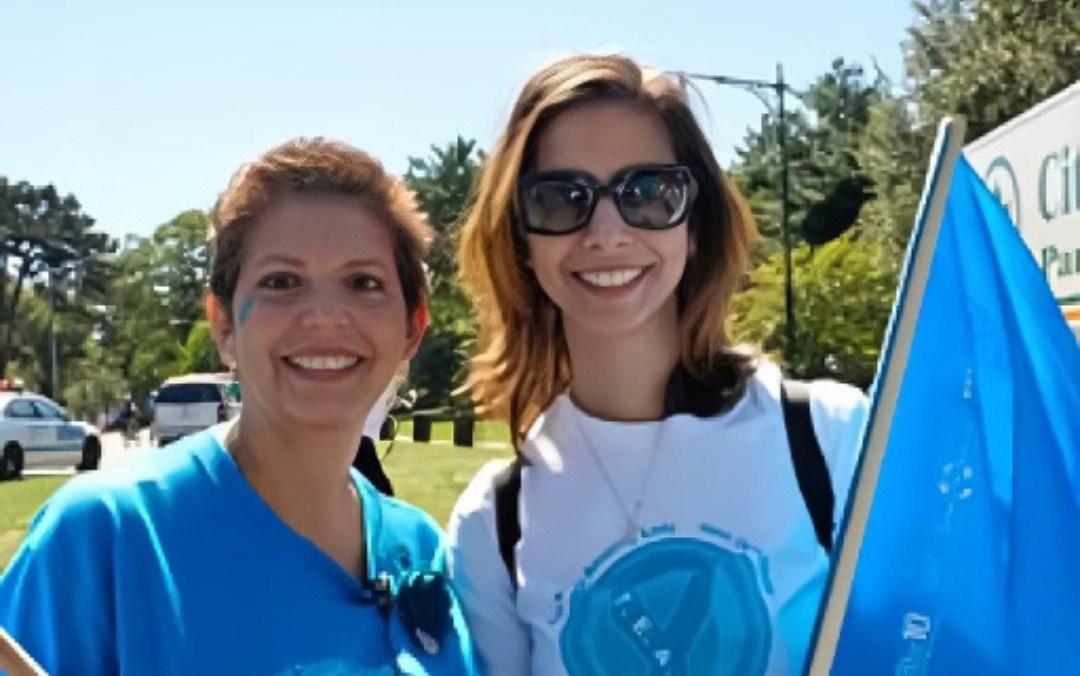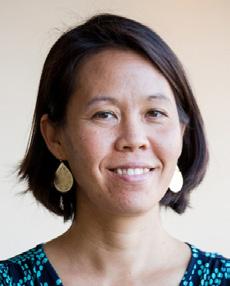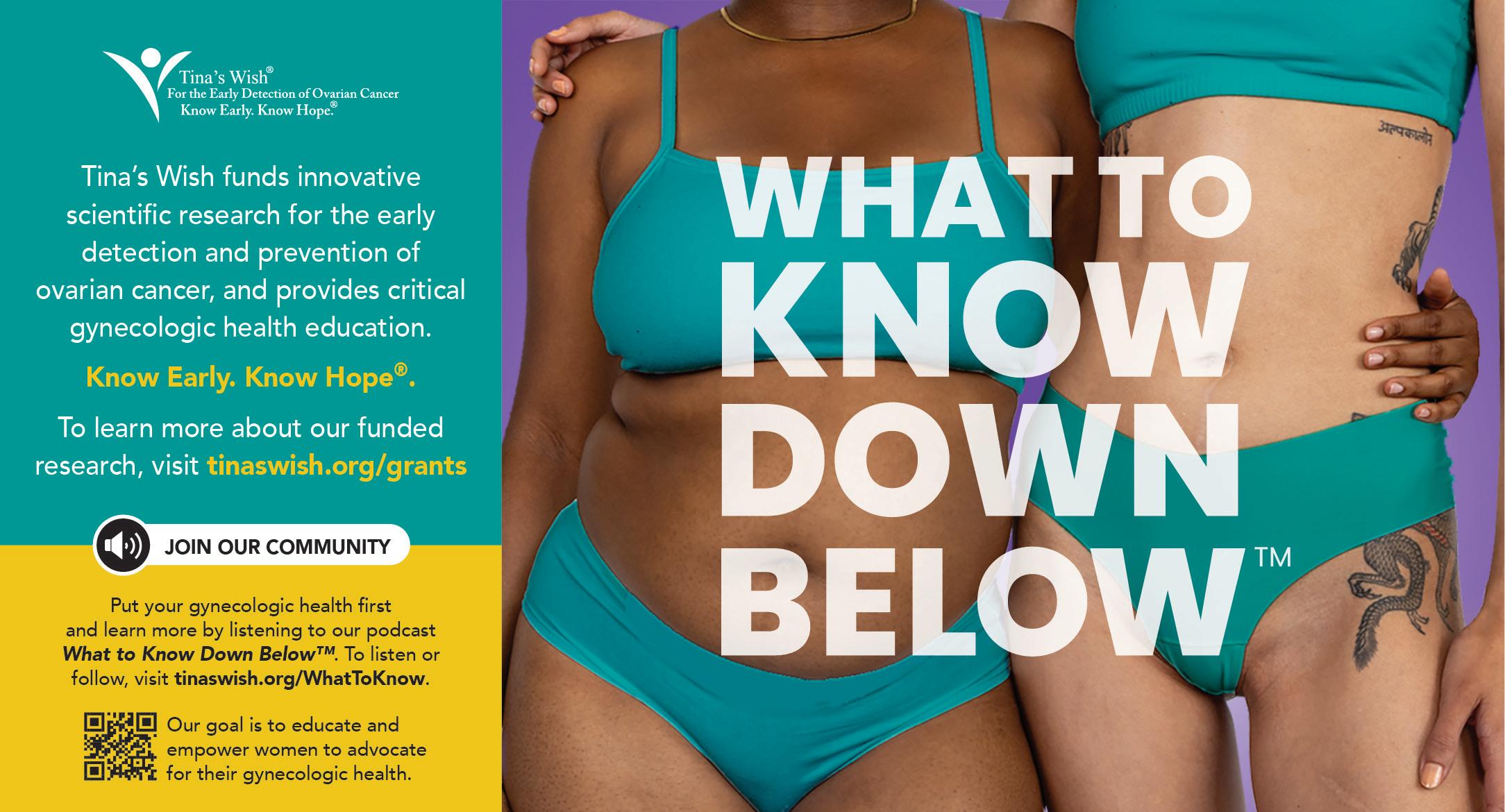Ovarian Cancer Awareness
“OCRA is committed to ensuring that all patients, regardless of race, income, or geographic location, have access to high-quality cancer care.”
Ovarian Cancer Research Alliance (OCRA) Page 07




“OCRA is committed to ensuring that all patients, regardless of race, income, or geographic location, have access to high-quality cancer care.”
Ovarian Cancer Research Alliance (OCRA) Page 07



diagnosis is a
In 2018, Jessica BeCraft’s cancer was discovered during an unplanned C-section for her daughter, Harper. At the time, she thought, “Low-grade means it must be early. I’m sure I’ll be fine.”
She would learn that “lowgrade” does not refer to the severity of the disease, but rather the type of cells, which are slow-growing and persistent. Unfortunately, this slower growth makes LGSOC harder to treat because it often doesn’t respond to the drugs that target other ovarian cancers.
Discouraged by the lack of treatment options and research funding, in 2020, Jess brought together two other women with LGSOC to create the first nonprofit in the United States dedicated to improving outcomes for the disease — STAAR Ovarian Cancer Foundation. The acronym stands for “Survive. Thrive. Advocate. Advance Research.”
Creating more optimistic outcomes for others
Jess’s cancer was not caught early. It was stage 3C. She knew she might not survive long enough to benefit from research funded by STAAR, but she was committed to improving the prognosis for others.
Jess BeCraft passed away at age 37 in September 2021. Another
of the co-founders, Alexandra Feldt, died a year earlier at age 34. The third, Bailey Wolfe, serves on STAAR’s all-volunteer board, which includes five other women with LGSOC.
What started with birthday fundraisers and a virtual Turkey Trot during the pandemic grew into a community where no one with LGSOC has to feel alone in their diagnosis.
In addition to contributing more than $600,000 so far to LGSOC research at leading institutions, STAAR has advanced understanding of the disease in collaboration with other organizations, including Cure Our Ovarian Cancer and the World Ovarian Cancer Coalition.
Last year, those partnerships led to the first-ever ovarian cancer patient meeting with the FDA and the first global survey about the patient impact of LGSOC.
A major takeaway from both is that although the cancer is rare, many have similar stories. The survey found that 99% of people had never heard of LGSOC before being diagnosed with it, and on average, it took nearly three years to get an accurate diagnosis.
Delayed diagnoses and improving education
Like other ovarian cancers, LGSOC has no early detection test and is frequently diagnosed in later stages because of a general

lack of awareness about the most common symptoms, which can include bloating, changes in bowel and urination habits, menstrual irregularities, and back pain.
Another challenge that’s delaying diagnoses is that LGSOC affects a younger demographic. Half of diagnoses occur before age 45. Two-thirds of the women surveyed said their healthcare providers initially dismissed their symptoms. Many diagnoses were delayed because of a misconception that 20 or 30 is too young to have ovarian cancer.
This younger age range means most people with LGSOC are premenopausal. Low-grade serous cells have been found to be estrogen-sensitive, so many patients take a hormone blocker to try to slow or prevent cancer growth. These women are thrust
into menopause decades ahead of their time, which affects fertility and libido. LGSOC literally steals years from their lives.
The low-grade community brought this to the attention of the federal agency responsible for evaluating new drugs during the patient meeting led by STAAR board chair Nicole Andrews.
“Our stories, experiences, and advocacy during the meeting served as a powerful catalyst,” Andrews said. “It brought attention to the urgent need for a deeper understanding of the challenges faced by those with low-grade serous ovarian cancer.”
Written by Kari Neumeyer, Vice Chair, STAAR Ovarian Cancer Foundation



Did you know the pap smear does not check for ovarian cancer?
Most annual exams do not include screening or a discussion about ovarian cancer. There is no accurate screening test for this deadly disease — a pap smear does not test for it. Ovarian cancer is the deadliest gynecologic cancer and the fifth-leading cause of cancer death among U.S. women.
Louisa’s story
Many people, like my late sister, Louisa — our original “amazing lady” — experienced symptoms that are easy to overlook and make diagnosis difficult. Louisa experienced increased back and pelvic pain, attributing it to a past injury and endometriosis. She had new gastrointestinal changes, such as feeling full quickly and unexplained weight gain. These were her first symptoms of ovarian cancer, and no one, not even doctors, knew it.
I remember one dinner before she was diagnosed, she couldn’t eat anything and felt like a balloon was pressing against her stomach. Louisa had prior surgeries, underwent many tests, and voiced her symptoms to doctors. The disease still went undetected because doctors don’t have the tools to detect it early. She finally received a pelvic sonogram, which revealed a suspicious mass. She soon had exploratory surgery and was diagnosed with stage 2C ovarian cancer.
When Louisa heard that the color teal symbolized ovarian cancer, she came up with the acronym, Tell Every Amazing Lady®. We started Tell Every Amazing

in 2009 in her hospital room, moved to our parent’s dining room, and then in 2015 we opened the T.E.A.L.® Ovarian Cancer Community Center in Brooklyn, New York; the only of its kind in the United States. We host events, workshops, and provide free resources nationally.
Ovarian cancer is the deadliest gynecologic cancer and the fifth-leading cause of cancer death among U.S. women.
We created a foundation whose mission includes all the things Louisa was looking for: a support system for ovarian cancer patients and families, a medical research program to find a screening test and improve treatment outcomes since ovarian cancer remains underfunded, a program that spreads awareness about signs and risk factors, and a wellness program for all.
September is National Ovarian Cancer Awareness Month and we want everyone to Tell Every Amazing Lady® about ovarian cancer! The symptoms are vague like back pain, bloating, pelvic or abdominal pain, frequent urination, gastrointestinal changes, nausea, or weight changes. Those with breast, colon, or any gynecological cancers in their family should consider genetic testing to learn if they might be at a higher risk for ovarian cancer. Our family has a genetic risk, so genetic testing can help save the lives of other family members.
Up until the very end, Louisa was advocating in her hospital bed, trying to help others and spread awareness. She left behind a husband and two children, but her fight lives on. Together we can save lives by ensuring that every amazing lady knows the signs and symptoms of ovarian cancer.
Written by Pamela Esposito-Amery, Co-Founder and CEO, T.E.A.L.®
ThisarticlewaspaidforbyT.E.A.L.®
Ovarian cancer remains one of the most aggressive gynecological malignancies. Traditional, platinum-based chemotherapy is the standard frontline treatment providing initial benefit for the majority of patients. However, the challenge of ovarian tumors being refractory or becoming resistant to platinum has continued to thwart long-term therapeutic success.
As the leading cause of death among gynecological cancers, the need for new and progressive treatments for ovarian cancer is urgent.
Enter Genelux Corporation — a biopharmaceutical company developing an innovative approach in hopes of addressing this high unmet medical need. Its therapy offers a potential option for patients struggling with platinum-resistant/refractory ovarian cancer (PRROC).
The challenge of platinum resistance or refractoriness Platinum-based chemotherapies, such as cisplatin and carboplatin, are integral in treating ovarian cancer. These drugs work by damaging the DNA of cancer cells, which prevents them from dividing and growing.
Initially, many patients respond well to these treatments, but over time, cancer cells can develop resistance or refractoriness to chemotherapy. This platinum resistance/refractoriness occurs in over 70% of patients with advanced ovarian cancer, severely limiting the effectiveness of subsequent line(s) of platinum-based treatments, as well as to other cytotoxic chemotherapies. Once resistance develops, the prognosis becomes poor, with few options left for patients.
Platinum resensitization aims to remodel the tumor microenvironment of cancer cells to be responsive to platinum-based chemotherapy, which is a longsought-after goal and has been referred to as the “Holy Grail” of gynecologic oncologists. This is
where Genelux’s approach has shown significant promise, offering a new strategy to (re-)sensitize cancer cells to platinum-based therapies.
Genelux’s innovative approach: Oncolytic immunotherapy
Genelux Corporation is at the forefront of developing oncolytic immunotherapies. Its lead candidate, olvimulogene nanivacirepvec (Olvi-Vec), is a proprietary, modified strain of the vaccinia virus, which is not a natural human pathogen and is designed to kill cancer cells while sparing healthy tissue.
This novel therapy not only directly attacks cancer cells but, in doing so, also stimulates the immune system to recognize and destroy tumors, and alters the tumor to potentially make it more susceptible to other therapies, offering a three-pronged approach to treatment.
One of the most promising aspects of Olvi-Vec is its potential to overcome ovarian tumor insensitivity to platinum-based chemotherapy. In clinical studies, Olvi-Vec has been shown to disrupt the cellular mechanisms that cancer cells use to evade the effects of platinum-based chemotherapy. In some patients, this disruption may allow previously resistant/refractory cancer cells to become susceptible to platinum drugs once again.
Clinical trials and future directions
In a Phase 2 trial (VIRO-15), heavily pre-treated patients, with a median of four prior lines of

therapy, received Olvi-Vec-primed immunochemotherapy. The results of the trial provided evidence that patients previously deemed platinum-resistant or -refractory demonstrated responsiveness to platinum-based therapy, and were observed to have achieved sustained and clinically meaningful benefit following treatment.1
Based on the positive results from the VIRO-15 Phase 2 trial, a Phase 3 registration trial (OnPrime) is currently enrolling patients at clinical sites throughout the United States without regard to their biomarker status or refractory tumor status, and without placing a cap on the number of prior lines of therapy. This trial is designed to demonstrate the benefit of Olvi-Vec by clinical reversal of platinum-resistance or refractoriness in PRROC patients.
Broader applications
The potential impact of Genelux’s novel virotherapy could extend beyond late-stage ovarian cancer. Olvi-Vec as a resensitizing agent to chemotherapies through its
immune modulating functions could potentially open the door to new treatment paradigms in earlier stages of ovarian cancer and other cancers that have developed resistance to standard therapies, which could offer renewed hope to patients with limited treatment options.
Written by Genelux
Scan the QR code for OnPrime clinical trial information:

REFERENCES
1. Holloway WH, Mendivil AA, Kendrick JE, Abaid LN, Brown JV, LeBlanc J, McKenzie ND, Mori KM, Ahmad S. “Clinical Activity of Olvimulogene Nanivacirepvec–Primed Immunochemotherapy in Heavily Pretreated Patients With Platinum-Resistant or Platinum-Refractory Ovarian Cancer — The Nonrandomized Phase 2 VIRO-15 Clinical Trial.” JAMA Oncology, https://genelux. com/wp-content/uploads/2024/04/2023Holloway-RW-et-al-JAMA-Oncol-Phase-2clinical-data-M.pdf.
The seven-time Olympic medalist and ovarian cancer survivor shares her story and advice for those enduring similar struggles.


Why is it more important than ever to educate women about ovarian cancer?
It’s important to educate women about ovarian cancer because all too often it’s caught at a later stage. Early detection saves lives and gives us more options. However, if we don’t know the signs and symptoms like I didn’t before my own diagnosis, we ignore seemingly benign issues like stomach aches, bloating, sudden weight loss, feeling full after eating a small amount of food (known as early satiety), and frequent urination. I also hope that the men in our lives learn the signs and symptoms of ovarian cancer. We’re all part of the team when it comes to our health and fighting ovarian cancer.
What was it like being diagnosed with a rare form of ovarian cancer?
It was at a routine appointment — one that I had almost canceled — when my doctor discovered a baseball-sized cyst on my left ovary during a pelvic exam. Initially, we had no idea what specifically we were dealing with. Was it benign? Would it go away on its own? Was it cancer? If so, had it spread? My world stopped. As a new mother,
my biggest fear was that my son wouldn’t have a mother.
Over the next several weeks, I went through various tests and scans that eventually led to surgery to remove the mass. After the surgery, I learned it was a rare form of ovarian cancer, but they had caught it early. However, I would need to go through an aggressive form of chemotherapy to give me the best chance of non-recurrence. During this journey, I’ve felt every emotion: fear, confusion, sadness, gratefulness, uncertainty, and so many others. I still have a difficult time understanding how I didn’t know that there was something this significant inside me. Once I began to recover from chemotherapy, I wanted to use any voice I had to help bring awareness to ovarian cancer — the importance of early detection, research, and survivorship.
What do you want to say to newly diagnosed women? You are not alone. I think that may be one of the most important things to remember, and sometimes it’s hard to remember. Early on, I felt the need to do this myself. I didn’t want to be a burden or complain and make others uncomfortable. However,
through the process, I learned a very important lesson: There is strength in not only accepting help when offered but also in asking for help when needed. You are not alone.
What resources are available that you wish more women knew about?
Get to know and love your nurse navigators! They are there to navigate your care by providing you with answers about your diagnosis and treatment. They coordinate your care by helping to get timely appointments, connect you with support services, and offer emotional support during this difficult time. They also have access to local support groups and foundations. Foundations provide services to help ease the burden patients often feel. Some
of the services they provide are transportation assistance by donating gas cards, emotional support through support groups for not only the patient but also their caregivers, and donating supplies that often reduce the side effects of treatment.
What is the biggest challenge surrounding ovarian cancer? Early detection is still a huge challenge. Women may not feel any physical symptoms until the cancer has progressed. That’s why, until there is a specific test for early detection, it’s critical to pay attention to your body and to keep your regular exams and screenings. Most importantly, be aware of the signs and symptoms, and feel confident to speak up when something feels off with your body.

Ovarian Cancer Research Alliance (OCRA) is the largest nonprofit organization in the world combating ovarian and all gynecologic cancers.
OCRA has invested over $122 million in research initiatives, helped secure $3.8 billion in federal funding for research and education programs, and annually supports and engages more than 95,000 individuals through comprehensive support programs and resources.
Saving more lives through genetic testing and preventive action
OCRA’s approach to prevention is groundbreaking, combining genetic testing with recommendations on preventive surgical options to help women reduce their cancer risk. OCRA’s free genetic testing, for those who qualify, identifies risk-elevating genetic mutations and empowers those at elevated risk to pursue preventive measures.
OCRA also strongly advocates for all women, even those at average risk, to talk with their doctors about removing their fallopian tubes at the time of other planned pelvic surgeries. Studies show that 70% of the most common and lethal ovarian cancer starts in the fallopian tubes, and this simple procedure, called opportunistic salpingectomy, can greatly reduce the risk of cancer.
Health equity in gynecologic cancer care
OCRA is committed to ensuring that all patients, regardless of race, income, or geographic location, have access to high-quality cancer care. Its online Doctor Finder allows users to enter their zip code and immediately

find the nearest gynecologic oncologists, specialists, and treatment centers, making it easier for patients to find the right care team for them, while OCRA’s Health Equity Research Grants are addressing barriers to care in underserved communities in order to ensure advances in treatment and prevention reach everyone.
With over $122 million invested, and an additional $6 million already committed for 2025, OCRA is the largest private funder of ovarian and related gynecologic cancer research worldwide, supporting scientists working toward better treatments and understanding of these diseases, and driving advancements that can benefit patients now and in the future.
As the only dedicated voice for the gynecologic cancer community on Capitol Hill, OCRA advocates on the state and federal levels for increased funding for gynecologic cancer research and education programs, drug and diagnostic safety, and access to preventive measures and quality care for all patients.
Empowering patients with support and resources
OCRA’s patient support programs are a model in the field, from its Patient Support Line (led
by highly experienced social workers) to its Woman to Woman Peer Mentor Program, and robust Staying Connected Support Series, which recently expanded its programming for Spanish-speaking patients, survivors, and caregivers.
OCRA’s newly launched ovarian and endometrial cancer patient registry, a first-of-its-kind collaborative initiative, aims to identify trends and better understand how these cancers progress, ultimately leading to improved therapies and outcomes. Its upcoming, groundbreaking Federated Data Network will allow researchers to share and access biodata from around the world, serving as a hub for international collaboration to accelerate our collective progress toward a cure.
Written by Ovarian Cancer Research Alliance (OCRA)
To learn more about OCRA’s work or get involved, visit ocrahope.org

The journey through ovarian cancer treatment is often marked by difficult decisions, emotional distress, and worry that the cancer could come back, as there is a high rate of recurrence.
In a recent study by the National Ovarian Cancer Coalition, over 63% of survivors and caregivers polled said that mental health is the number one topic they would like support on.
In times of overwhelming stress, it’s common to turn to distractions like organizing or cleaning to regain a sense of control. However, these activities often overlook a more critical need — decluttering our mental space.
By focusing on mental well-being, we can better manage life’s stressors, especially when faced with significant challenges like a cancer diagnosis. Here’s a checklist to help you clear out mental clutter and make room for peace, joy, and renewal:
1. Acknowledge your feelings
Stop avoiding and start reflecting. Recognize the thoughts or emotions clouding your mind. Facing these issues is the first step toward mental clarity.
2. Write it down
Journaling can lighten your mental load. Putting fears and worries on paper often brings clarity and relief, helping you manage your emotions more effectively.
3. Be honest with yourself and others
Confront how you feel and communicate openly with friends or family. Avoiding issues can lead to more stress, while honesty can clear the air and ease emotional burdens.
4. Reach out for support
Isolation can worsen anxiety and

depression, yet it’s often where we retreat when struggling. Let others know how you’re feeling and ask for help when needed.
5. Share the mental load
Don’t carry your burdens alone. Sharing your struggles with someone you trust or seeking support can make a significant difference and provide much-needed relief.
6. Incorporate physical activity
Exercise can improve mental health, yet it’s easy to put off. Start small — whether it’s a short walk, a yoga session, or any physical activity. Even minor actions can lead to substantial emotional gains.
7. Engage in creative activities
Pursue projects or hobbies that inspire you. Creativity can provide a healthy outlet for your emotions
and foster a sense of accomplishment and joy.
8. Complete a project
Finish something you’ve started. Accomplishing a task, no matter how small, can boost your mood, provide satisfaction, and create a sense of achievement.
9. Prioritize laughter and positive relationships
Spend time with people who make you laugh. Positive friendships and humor can be incredibly cleansing and uplifting, helping you maintain a brighter outlook.
10. Be intentional with your mental health
Make a conscious effort to remove negative thoughts, habits, and influences. Focus on filling your mind with positivity, appreciation, and things that bring you joy.
Lasting benefits
“Head housework,” while challenging, offers lasting benefits for mental well-being. By being intentional in decluttering your mind, you can free up space for things that bring you delight, harmony, and even a little amusement.
Treat this process as an opportunity to redefine your expectations, rediscover yourself, and create room for positivity and growth. With a clearer mind, you may find that the doors you’ve been seeking are finally within reach.


When you’re diagnosed with cancer, the more information doctors can learn about your tumor at diagnosis, the better.
That’s especially true when it comes to advanced ovarian cancer. Knowing your tumor’s HRD status can help your healthcare team treat your unique type of cancer.1 Getting tested may help them identify the appropriate treatments for you.1
What is HRD?
HRD stands for homologous recombination deficiency. That sounds like a complicated term, but the basic idea is simple: HRD means cells can’t repair certain types of DNA damage. HRD can be determined by the presence of individual mutations in breast cancer susceptibility genes 1 or 2 (BRCA1 or BRCA2) and/or instability in cells, which can lead to cancer.1,2
Why get tested?
If you’ve been diagnosed with advanced ovarian cancer, the HRD test can provide some important clarity, showing how your tumor may respond to certain treatments.1 About 50%
of people with advanced ovarian cancer have tumors that test positive for HRD.1
Tumor testing vs genetic testing
You might hear some unfamiliar terms when you talk to your doctor about testing. There are multiple types of tests, and they provide different sorts of information.
Tumor Testing: An HRD test is a tumor test, also known as a genomic test or a biomarker test. Tumor testing looks at all the genes in your tumor’s DNA and can find both inherited and acquired mutations.3 It can identify changes that affect cancer behaviors and inform treatment.1
Genetic Testing: Examines specific inherited genes in your DNA, such as BRCA1 and BRCA2. Genetic tests can help identify the potential risk of developing certain diseases, including some cancers. A blood or saliva sample will be collected for a genetic test. 1,2
“Educating women about their HRD status by getting tested is one of the ways AstraZeneca is trying to equip women with the information they need to understand their advanced ovarian cancer better,” said Roula Qaqish, U.S. medical franchise head, women’s cancer, AstraZeneca.
How do I get tested, and what happens after?
After diagnosis, the first step is asking your doctor about getting an HRD test. Testing will include taking a tumor tissue sample, during surgery or via a biopsy.1 Depending on the results of your tumor’s HRD status, treatment may include 4: ⁴
• Surgery
• Chemotherapy
• Targeted treatment
If you’ve been diagnosed with advanced ovarian cancer, ask your doctor about HRD testing. “We want every woman to feel confident that they have the right information to have meaningful conversations with their doctors and make the best decisions for their care,” Qaqish said.
1. Medical News Today. What to know about HRD testing for ovarian cancer. Accessed September 2024. https://www. medicalnewstoday.com/articles/hrd-positive-ovariancancer.
2. National Cancer Institute. BRCA Gene Changes: Cancer Risk and Genetic Testing. Accessed September 2024. https://www.cancer.gov/about-cancer/causes-prevention/ genetics/brca-fact-sheet.
3. National Cancer Institute. Biomarker testing for cancer treatment. Accessed September 2024. https://www. cancer.gov/about-cancer/treatment/types/biomarkertesting-cancer-treatment.
4. Centers for Disease Control and Prevention. Treatment of Ovarian Cancer. Accessed September 2024. https://www. cdc.gov/ovarian-cancer/treatment/index.html.
Written by Melinda Carter
©2024 AstraZeneca. All rights reserved. US-93499 9/24
For inspiration on what questions to ask during your appointment, AstraZeneca offers a doctor discussion guide at testforHRD.com

As Ovarian Cancer Awareness Month in the United States and Gynecological Cancer Awareness Month in Europe comes to a close, the global ovarian cancer community is presented with a unique opportunity to enhance our efforts, raise awareness, and advocate for the essential changes that will save lives.
This month is not merely a time to reflect on the progress we have achieved, but also an opportunity to pay tribute to the many advocacy organizations that work year-round on behalf of those living with, or at risk of, the disease, getting us closer to “No Woman Left Behind.”
Ovarian cancer remains one of the most formidable challenges among all female cancers, with survival rates alarmingly low across the globe. Despite advancements in some regions, the burden of this disease continues to intensify, particularly in lowand middle-income countries. Overall, the statistics are deeply concerning. By 2050, nearly half a million women are expected to be diagnosed with ovarian cancer annually.
This increase in incidence is matched by a heartbreaking rise in mortality. If we do not act, 8 million women could lose
their lives to ovarian cancer by 2050 — a figure that underscores the urgency of our mission. The disparities in access to care, early diagnosis, and effective treatment are glaring, and they manifest differently across all regions. However, the common thread is clear: These inequities must be addressed if we are to ensure that no woman is left behind.
As a global organization, our commitment to ”No Woman Left Behind” is more than just a motto; it is the cornerstone of our work. We believe in addressing the inequities that exist at every stage of the ovarian cancer journey. From the lack of access to diagnostic tools in some regions to the prohibitive costs of treatment in others, the obstacles are numerous and varied. Yet, our resolve remains steadfast. We feel strongly that everyone living with, or at risk of, ovarian cancer deserves
the best chance of survival and the highest quality of life possible, no matter where they live.
We are immensely proud of the work that our 200+ partner organizations do worldwide. They work tirelessly on the front lines — whether through awareness initiatives, patient support, or pioneering research. Their efforts form the foundation of our collective mission. Together we are driving significant progress, but there is still much work ahead. This month, as we unite to mark Ovarian Cancer Awareness Month, we are proud to reaffirm our commitment to supporting these organizations in their vital work.
The World Ovarian Cancer Coalition is dedicated to ensuring that our partners have the resources, knowledge, and backing they need to continue their life-saving endeavors. Whether through
year-round initiatives, awareness days or months, or on our annual World Ovarian Cancer Day on May 8, we stand in solidarity with our partners, stakeholders, and the women they serve.
This Ovarian Cancer Awareness Month, let us not only celebrate the milestones we have reached but also acknowledge the challenges that lie ahead. Let us continue to advocate for change, raise awareness, and, most importantly, ensure that no woman is left behind in our global fight against ovarian cancer. Together, through collaboration and shared determination, we can and will transform the future of this disease — one life at a time.

Although ovarian cancer research has improved over the past decade, a lack of biological understanding and screening options still results in one of the deadliest cancer outcomes.
Why is it so difficult to detect ovarian cancer early?
There are no symptoms until the cancer is at an advanced stage, meaning it’s already metastatic. That’s why it’s called a silent killer — by the time you develop symptoms from it, you have the disease throughout the abdomen.
Why is it important to research ways to better detect ovarian cancer early on?
We know from ovarian cancer and the majority of other cancers that if we catch it early, we can save people’s lives. If you are diagnosed with ovarian cancer at stage 1, your chances of cure are greater than 90%. If you catch it at stage 3 or stage
4, your chances of cure are much lower, in the 30% range.
Have there been any recent breakthroughs in early detection of ovarian cancer?
I think one of the most important discoveries is that most of these high-grade serous ovarian cancers actually start in the fallopian tube.
Once a woman is done childbearing, the fallopian tubes are not necessary for her health, so there is a push toward opportunistic salpingectomy, which means taking the fallopian tubes out any time you’re in the belly for another reason, such as a gallbladder surgery or hysterectomy. If you’re going to have your tubes tied for contraception, instead of
tying the tubes, actually take out the fallopian tubes entirely. Then you’re taking out the source of these cancer cells. It’s something that is relatively low risk if you’re having surgery anyway, and it doesn’t impact your hormonal status. It doesn’t put you into menopause.
What can our readers do to increase their chances of detecting ovarian cancer earlier, before screening is available? Awareness is critical. We need to understand that all women are at risk for this. Be aware of your body. Talk to your doctor if you’re done with childbearing. If you’re having another surgery, consider having your fallopian tubes removed.


